Few places in the world are as majestic, powerful, and mysterious as the Himalayas. Soaring peaks, arid plains, and people groups from diverse backgrounds dot this region and define it both geologically and culturally. Today, we are going to explore ten of the most incredible facts about the Himalayas and dive into what makes the region so special. Let’s get started!
It Has The Highest Peaks in the World

The tallest mountain in the world is Mount Everest, and the Himalayas have multiple peaks over 8,000 meters.
©Vixit/Shutterstock.com
One of the most incredible facts about the Himalayas is that it has the highest peaks in the world. The Himalayas are a mountain range that stretches across Asia, covering parts of India, Nepal, China, Pakistan, Bhutan, and Afghanistan. The Himalayas are home to more than 110 peaks that reach heights of at least 7,300 meters (24,000 feet) above sea level. Within that incredible list of peaks, 12 of them surpass 8,000 meters (26,247 feet), earning them the name “eight-thousanders”. These are the highest and most challenging mountains to climb in the world and are all immense in a way that can be hard to conceptualize!
The highest peak in the Himalayas and in the world is (famously) Mount Everest, which stands at 8,848.86 meters (29,032 feet). It is located on the border between Nepal and China and is also known as Sagarmatha in Nepali and Chomolungma in Tibetan. The second highest peak in the Himalayas, and the third highest in the world, is Kanchenjunga, which rises to 8,586 meters (28,169 feet).
It Spans Five Countries
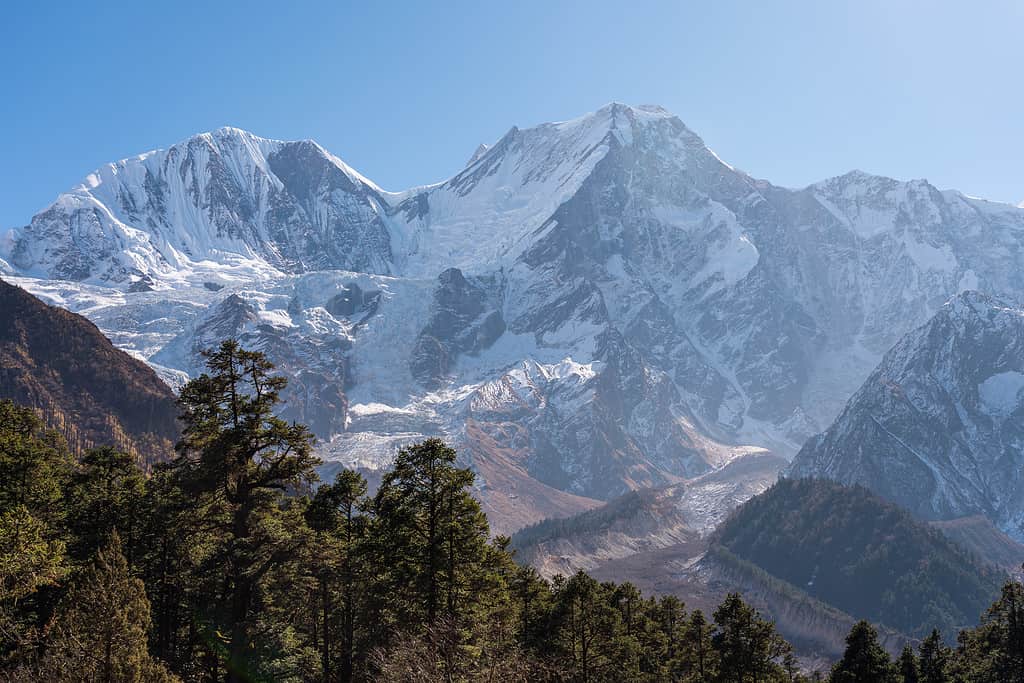
Countries like Nepal, Bhutan, and Pakistan are heavily influenced by the nearby range.
©iStock.com/Skazzjy
Another incredible fact about the Himalayas is that it spans five countries. The Himalayas are a mountain range that stretches across Asia, covering parts of India, Nepal, China, Pakistan, and Bhutan. Nepal is known as the land of the Sherpas and is truly a nation made of mountain people. China has the Tibetan Plateau, which is the highest and largest plateau in the world and the source of many major rivers. India has the Ladakh region, which is a cold desert with some ancient monasteries. No matter the country, the people have found a way to live in extremely unique ways as a result of the harsh environment. Around 40 million people live in the Himalayas, although the combined drainage basin is home to some 3 billion people in 18 countries (almost half the world’s population).
It’s Name Means “Abode of the Snow”
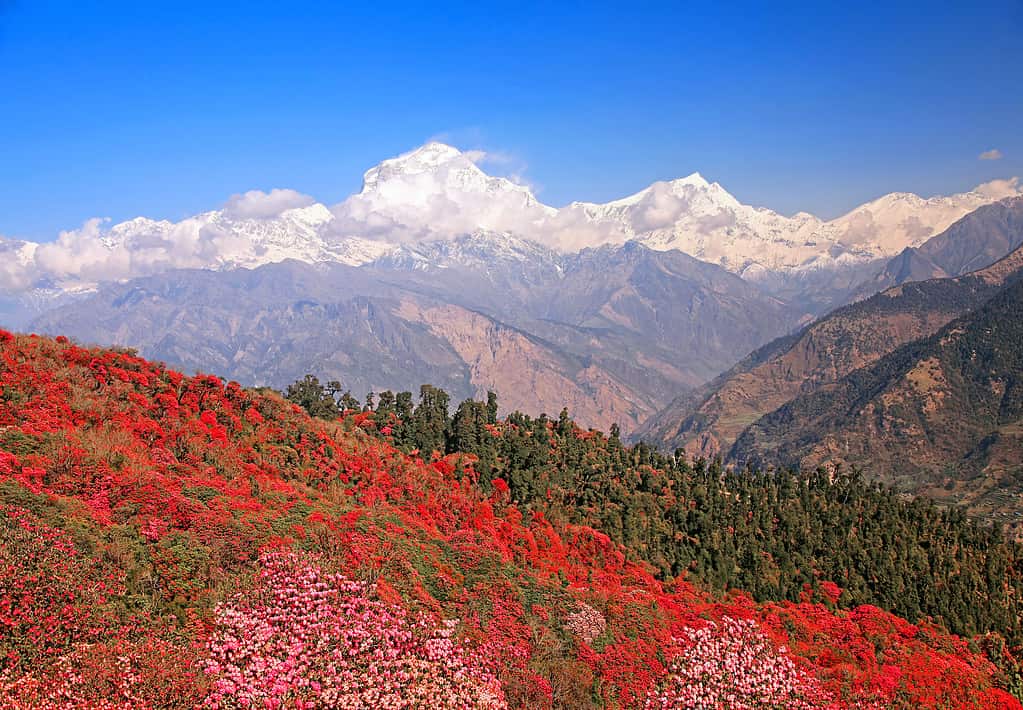
The snow line in the Himalayas represents the spot that snow is a permanent feature of the mountain.
©Kiwisoul/Shutterstock.com
The name Himalaya comes from the Sanskrit word himālaya, which translates to “abode of the snow” (or “snow abode” more directly). It’s pretty clear where the name comes from, but what’s lesser known is that there are regions within the range that permanently have snow due to their height.
The name Himalaya is not the only name that the mountain range has. Different cultures and languages have their own names and interpretations of the Himalayas. For example, in Tibetan, the Himalayas are called Gangs-ri (གངས་རི་), which means “snowy mountains”. In Nepali, the Himalayas are called Himāl (हिमाल), which is a shortened form of himālaya. In Chinese, the Himalayas are called Xǐmǎlāyǎ Shānmài (喜马拉雅山脉), which is a transliteration of the original Sanskrit name. There are even more names and translations of them, but most of the names either reference the snow or the power of the mountains themselves.
They Were Formed From India Crashing Into Eurasia (and Are Still Growing)
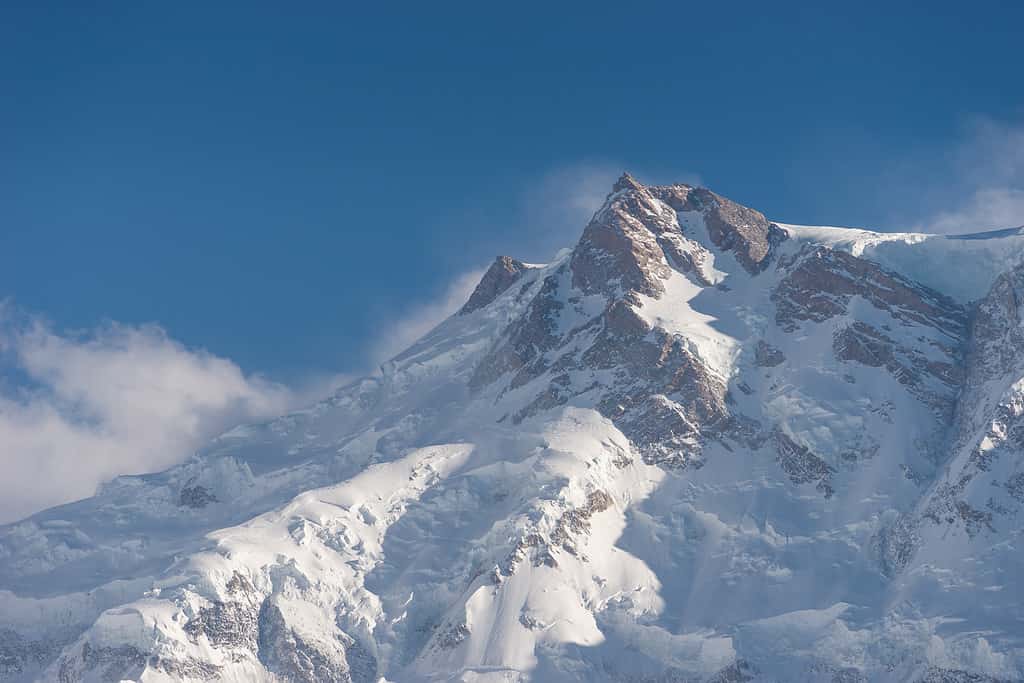
The Indian tectonic plate collided with the Eurasian plate, creating the
Himalayan
range where they met.
©iStock.com/Skazzjy
The Himalayan range itself comes as the result of a huge collision between two tectonic plates, the Indian Plate and the Eurasian Plate. The “crash” began about 50 million years ago and continues today, pushing the mountains higher and higher.
The Indian Plate, which was once a large island situated off the coast of Australia, moved northward at about 15 cm per year until it hit the Eurasian Plate. The impact of the two plates is essentially folding up the edges of both plates, creating the Himalayan mountain range and the Tibetan Plateau. At the same time it hit, it closed an ancient ocean named the “Tethys Ocean”. Since the plates are still moving towards each other, the Himalayas are still rising by about 5 mm per year.
They Contain Huge Amounts of Ice and Snow
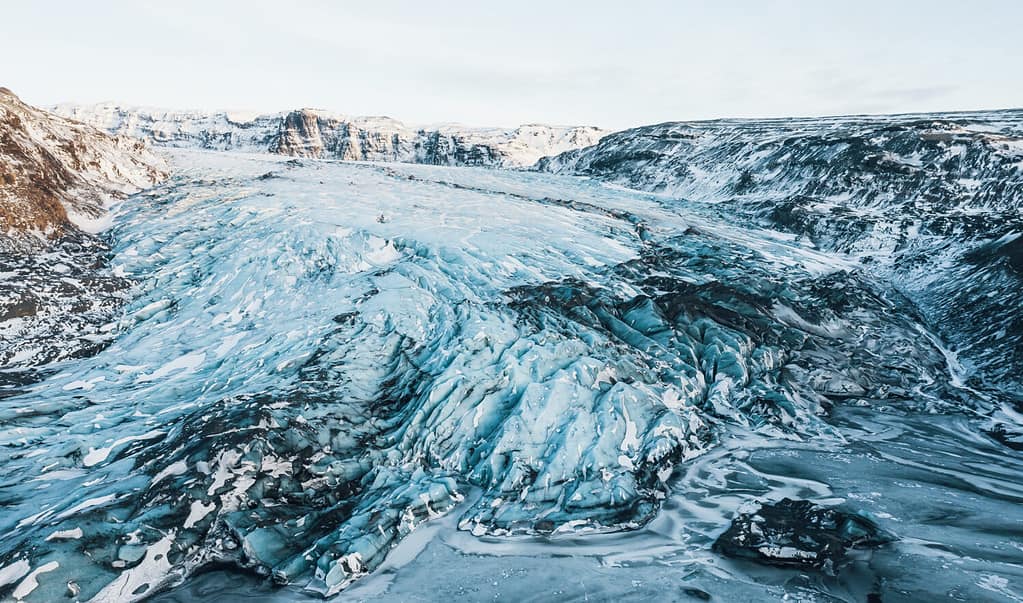
The snow and glaciers block solar radiation and help keep the planet cool.
©MT-R/Shutterstock.com
The Himalayas are not only the highest mountain range in the world, but also a storehouse of ice and snow. On average, they contain the third-largest deposit of ice and snow in the world, after Antarctica and the Arctic, giving it the nickname ” the Third Pole.” Over the range, the Himalayas have about 15,000 glaciers, which store about 2,900 cu mi) of fresh water. At the same time, the snow in many areas never melts. This snowline is one of the highest in the world, at around 5,500 m (18,000 ft), and as a result, it has a drastic impact on regional climate events. Ultimately, it reflects solar radiation and influences the monsoon circulation for all of Asia, and changes in snow cover can affect the temperature, precipitation, and wind patterns across the continent.
The Wildlife is Extremely Unique and Rare
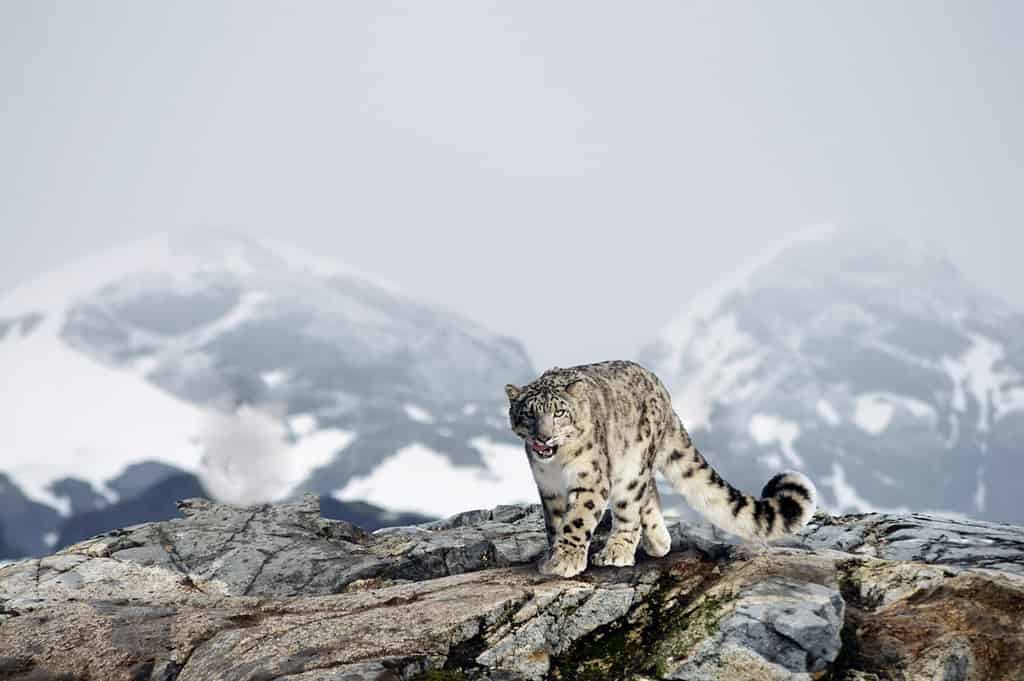
The snow
leopard
is one of the most elusive animals on the planet and lives in the Himalayas.
©Asmakhan992/Shutterstock.com
The vast range of the Himalayas has resulted in some of the world’s most unique creatures. Isolation and extreme conditions have forced the animals that live there to adapt in some truly unique ways, and as a result, the area has hundreds of strictly endemic species (they only live there and nowhere else). Most people have heard of the apex predator of the Himalayan range, the snow leopard. They were historically nearing extinction but have been pulled back from the brink thanks to intentional conservation on the part of humans. Some other animals that live in the region include the red panda (a small animal that eats bamboo in the eastern parts of the range), the Himalayan Tahr, a goat-like animal that can climb cliffs, and the takin, a cow-like animal with thick fur (it’s also the national animal of Bhutan).
It’s a Religious Birthplace and Destination

Hinduism and Buddhism have roots either in or nearby the Himalayan range.
©Alex. Shevchenko/Shutterstock.com
The isolation, power, and feeling of majesty you get from being in the mountains lends itself to religious ideation, and there’s probably not a better example of that than the Himalayan range. This region has been the birthplace of many religions, and to this day, pilgrimages, temples, and extraordinary monasteries are foundational to the culture of the area.
Hinduism, the oldest and most diverse religion in the world, has its roots in the Himalayas. The Himalayas are where Shiva and Parvati live, for reference. The Himalayas are also the source of the holy river Ganga, which they believe to have originated from Shiva’s hair.
Additionally, Buddhism has a strong connection with the Himalayas. Buddhism was founded by Siddhartha Gautama, who was born near the foothills of the Himalayas in present-day Nepal. He attained enlightenment in Bodh Gaya and preached his first sermon in Sarnath, both near the Himalayas. Additionally, Sikhism and Jainism are rooted in the area around the Himalayas.
Some of the most famous temples and religious buildings in the Himalayas include the Badrinath Temple, the Muktinath Temple, the Jokhang Temple, and the Paro Taktsang.
A Fifth of Certain Plants in the Region Are Medicinal

Many of the plants in the region are medicinal and have been used for centuries by native people groups.
©Juver/Shutterstock.com
The Himalayas are a hub for medicinal plants. Incredibly, nearly a fifth of the plants in the region have healing properties. These plants have been used for centuries to treat things as simple as cough, all the way up to snake bites!
- Abies pindrow: a coniferous tree where the bark was used to treat coughs and colds.
- Andrachne cordifolia: a bush used to create a healing paste for injuries and sometimes snakebites.
- Juniperus tibetica: a juniper tree with leaves and berries harvested for teas and other medicines. It’s also the highest-known tree species in the Himalayas.
The Range Prevented Ancient Interactions Between India, China, and Mongolia
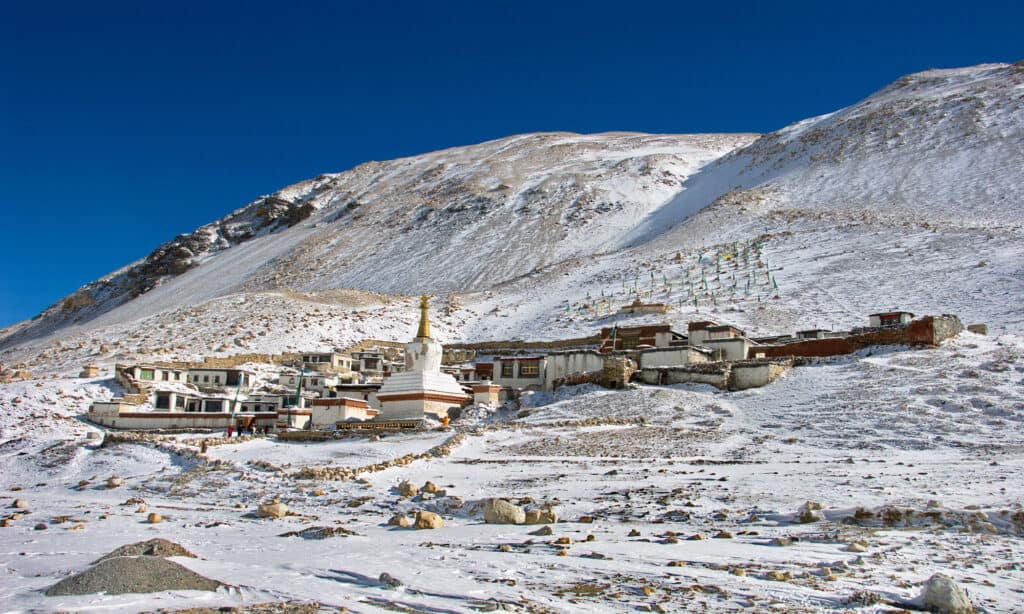
Without the isolation and division of the range, who knows how history would have progressed in East Asia?
©iStock.com/TomazKunst
The Himalayas are a natural barrier that isolated India, China, and Mongolia for thousands of years. The Himalayas are the highest mountains in the world, and they are just really hard to cross for a human on foot!
As a result, this limited the cultural exchanges between these civilizations, resulting in distinct differences in their development and history. The Himalayas also protected these civilizations from invasions and conflicts with their neighbors to some extent. However, the Himalayas were not completely impassable, as there were some trade routes and pilgrimages that connected the regions through mountain passes.
Who knows how the world could look today if these cultures interacted more frequently in ancient times?
Everest Was First Climbed By Sir Edmund Hillary and Tenzing Norgay

The first people to ever summit Everest were Sir Edmund Hillary and Tenzing Norgay and they did it nearly 75 years ago in 1953.
©Uwe Gille, CC BY-SA 3.0, via Wikimedia Commons – Original / License
Everest is the highest mountain in the world and one of the most challenging to climb. It was first climbed by Sir Edmund Hillary and Tenzing Norgay on May 29, 1953. They spent about 15 minutes on the summit, and during that time, they took photographs, planted flags, and left offerings. The summit is so high that a human can’t stay for too long without losing consciousness, so timing or having portable oxygen is essential. They didn’t have the same technology that we do today, which adds a layer of awe to the whole endeavor.
There probably isn’t any other place in the world like the Himalayan Mountains. The impressive peaks are one thing, but the immense spaces, cultures, religions, and sheer beauty of this part of the world are truly something else. As a natural space, it’s worth protecting, and the cultures within it are worth preserving. Examples of success stories do exist, and the snow leopard is a perfect one. Nearing extinction, it was able to be saved due to intentional preservation from humans. Hopefully, we can continue to protect the Himalayan Mountains in the future so they will continue to operate as a global icon for so much in the future.
The photo featured at the top of this post is © bodrumsurf/Shutterstock.com
Thank you for reading! Have some feedback for us? Contact the AZ Animals editorial team.







